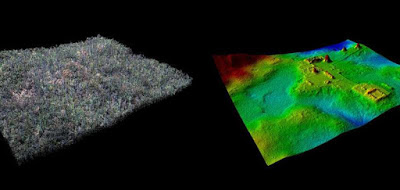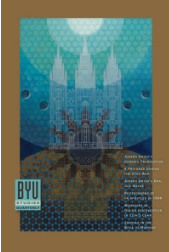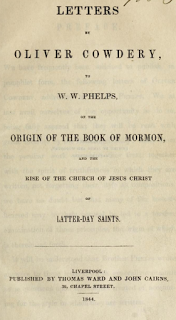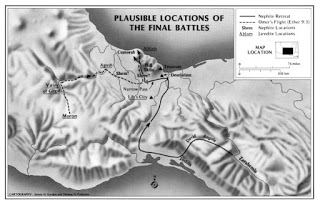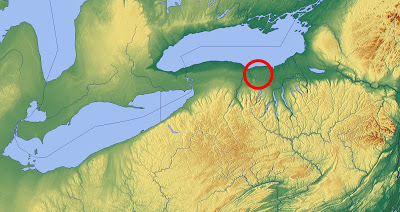Getting real about Cumorah – Part 5a, how M2C infiltrates the Church
“I’m not sure what is behind the increasing attacks upon the Prophet Joseph Smith in our current time, but one thing is for sure: it is increasing.”
He should take a look a what is going on at BYU/CES and in certain departments of the Church. That is where the most insidious attacks are taking place.
Jana Riess recently commented on her study of why Millennials leave the Church. She said that “Among Millennials, the top five answers were:
“I felt judged or misunderstood.”
[tied for first] “I did not trust the Church leadership to tell the truth surrounding controversial or historical issues.”
Anyone interested in why Millennials reach these conclusions should also look at what is going on at BYU/CES and in certain departments of the Church.
When students at BYU/CES are taught that the prophets and apostles are wrong about such a fundamental, straightforward issue as the New York Cumorah, how could they not reach the conclusion that Riess has identified? Especially when the intellectuals at BYU/CES are actively suppressing what the prophets and apostles have taught?
It is anything but a winning strategy to expect Millennials (or investigators, or anyone else for that matter) to remain ignorant of what Church leaders have so consistently and explicitly taught as the fact that the Hill Cumorah is in New York.
On top of that, thanks to the Church History Department, visitors to the Hill Cumorah today are never informed about the truth, leaving them confused and even bewildered about what to believe.
_____
Some have proposed a new twist. This is the idea that maybe the prophets and apostles were merely speaking according to their best understanding, but now the BYU/CES intellectuals have discovered the truth so we no longer care what the prophets and apostles have said in the past.
IOW, the prophets and apostles were wrong, even when they declared this was a fact and they bore testimony of it in General Conference, but it doesn’t matter because as long as we accept what the intellectuals approve of today, we are not expected to believe what the prophets and apostles have taught in the past.
Think about the implications of that one for a moment.
The absurdity of all this is that there is more physical evidence to support the prophets and apostles than there is to reject them.
Unless you are obsessed with confirming your bias about M2C.
_____
 |
| BYU/CES intellectuals explain Letter VII to their students |
This cartoon frames the issue in terms of cognitive dissonance, but it could also have framed it in terms of bias confirmation.
This problem is even more serious than I realized when I started working on this issue a few years ago. I greatly underestimated the amount of bias confirmation I would encounter among intellectuals at BYU/CES and in Church departments.
There is definitely a lot of bias confirmation going on in the world. It’s a major cause of disagreements ranging from interpersonal arguments to international conflicts. But I can’t think of an application where it is more powerful than in the M2C context.
(M2C is the acronym for the Mesoamerican/two-Cumorahs theory.)
Bias confirmation is so psychologically powerful that it drives faithful LDS scholars to promote M2C by rejecting the prophets and apostles, even while they are teaching their students to follow the prophets and apostles.
I frequently hear from readers, including students at BYU, who are observing this behavior on the part of the faculty. The intellectuals’ rejection of the prophets and apostles is manifest in the fantasy map being taught at BYU campuses and Institute classes throughout the Church, as well as in sundry Church exhibits and media.
_____
It is no surprise that what is taught in schools and universities is eventually accepted by society. It is no different in the Church. Children taught from Primary through BYU that the Hill Cumorah is in Mexico will accept it, especially when they are never taught what the prophets and apostles have taught about the New York Cumorah. In this sense, the M2C intellectuals have been highly successful in their efforts.
In fact, now their own students teach at BYU/CES and have become so bound by their M2C bias confirmation that they are psychologically incapable of even considering the possibility that the prophets and apostles are correct about the New York Cumorah. They reject the idea out of hand.
This reality surprises many older LDS who grew up when the New York Cumorah was taught by the prophets and apostles in General Conference. After all, the BYU/CES teachers are trusted with tremendous responsibility for teaching the rising generation in the Church. How could they so blatantly and even proudly teach the youth that the prophets and apostles are wrong?
Their delight in teaching M2C may be a front to hide their cognitive dissonance. It’s obvious they are uncomfortable with what they are doing. Their preferred technique is to keep their students ignorant of what the prophets and apostles have taught so they never have to face tough questions from students. They never include Letter VII in their materials or presentations.
The staff in the Church History Department colludes with their former professors to keep Letter VII as hidden as possible. They don’t want people to know about it, and they have been successful; most members of the Church (especially the younger ones) have never learned what President Cowdery had to say about the New York Cumorah. Church M2C staffers not only don’t want members to know that so many prophets and apostles affirmed what President Cowdery taught; they don’t even want people to know why they taught this.
Fortunately for truth-seekers, Joseph had his scribes copy President Cowdery’s letters into his own history as part of his life story. They can’t be completely suppressed. Today, anyone can read them in the Joseph Smith Papers. Letter VII is here, for example.
But look at the Editorial Note in Joseph Smith, History, 1834-1836, and see how carefully the editors avoided informing readers what the letters had to say about Cumorah and how ubiquitous these letters were when Joseph was alive. You would never know from these notes that Joseph encouraged the republication of these letters in the Times and Seasons, the Gospel Reflector, the Prophet, and the Millennial Star. You would never know that Joseph F. Smith republished them again in Utah in the Improvement Era.
Even the staff in the Missionary Department is in on this. They removed Articles of Faith and A Marvelous Work and a Wonder from the list of approved reading materials for missionaries. Both of those books specifically identified the “hill in New York” as the one Cumorah of the Book of Mormon. The department changed the artwork in the missionary edition of the Book of Mormon from teaching the one New York Cumorah to teaching the M2C theory. They created exhibits in the Visitors Centers to teach M2C (Mesoamerican/two-Cumorahs). And they put up M2C graphics in the MTC and named buildings after early Church leaders and missionaries, but they don’t tell the missionaries that these apostles taught the New York Cumorah.
This deliberate effort to suppress the New York Cumorah is even more widespread among Church staffers. For example, I’ve shown how the Curriculum Committee edited the Wentworth Letter to omit an important paragraph that Joseph Smith wrote. This, despite Joseph having introduced the letter by writing to the intended publisher “all that I shall ask at his hands is that he publish the account entire, ungarnished, and without misrepresentation.”
Joseph didn’t need to worry about Mr. Barstow; he needed to worry about the Curriculum Committee.
Here’s what I wrote in the previous post about
“the well known suppression of an important part of the Wentworth letter in Chapter 38 of the manual, Teachings of the Presidents of the Church: Joseph Smith.
If you want to read the entire letter, you can see it on lds.org at this link: https://www.lds.org/ensign/2002/07/the-wentworth-letter?lang=eng
[Note: that was published in 2002, before M2C completely took over.]
But you can’t read the entire letter in the lesson manual because the following passage was omitted:
Lesson manual (note the ellipses):
“Through the medium of the Urim and Thummim I translated the record by the gift and power of God.… This book … tells us that our Savior made His appearance upon this continent after His resurrection;”
Original letter (with the omitted portions in red):
“Through the medium of the Urim and Thummim I translated the record by the gift and power of God.
“In this important and interesting book the history of ancient America is unfolded, from its first settlement by a colony that came from the Tower of Babel at the confusion of languages to the beginning of the fifth century of the Christian era. We are informed by these records that America in ancient times has been inhabited by two distinct races of people. The first were called Jaredites and came directly from the Tower of Babel. The second race came directly from the city of Jerusalem about six hundred years before Christ. They were principally Israelites of the descendants of Joseph. The Jaredites were destroyed about the time that the Israelites came from Jerusalem, who succeeded them in the inheritance of the country. The principal nation of the second race fell in battle towards the close of the fourth century. The remnant are the Indians that now inhabit this country. This book also tells us that our Savior made His appearance upon this continent after His Resurrection;”
_____________________
It’s bad enough that they deleted the important passage in red, but they even deleted the “also” so readers would have no idea that the Book told us something else important.
[Note: this lesson manual has been translated into many languages and is the main source of Joseph Smith’s teachings today. Consequently, millions of members of the Church are being deliberately misled about the Prophet’s teachings and will never realize it–especially future generations.]
_____
I could cite more examples of how M2C has infiltrated the Church, but let’s instead consider how Oliver and Joseph might have responded to this change in the Church’s course.
One reason why I think President Cowdery’s eight historical letters should be part of the BYU/CES curriculum (as well as the Gospel Doctrine curriculum) is because they address problems that Joseph Smith faced that remain issues today.
Here’s an example.
In Letter II, President Cowdery wrote:
“I cannot reasonably expect, then, that the large majority of professors will be willing to listen to my argument for a moment, as a careful, impartial, and faithful investigation of the doctrines which I believe to be correct, and the principles cherished in my bosom and believed by this church, by every honest man, must be admitted as truth.”
The syntax is a little awkward perhaps, but he is saying that most professors would not listen to his arguments because if they did so with an open mind, they would have to admit they were true.
This is what bias confirmation does to one’s mind.
For those who have never studied bias confirmation, there’s a nice overview on wikipedia, here:
https://en.wikipedia.org/wiki/Confirmation_bias
This excerpt explains it pretty well.
“Some psychologists restrict the term confirmation bias to selective collection of evidence that supports what one already believes while ignoring or rejecting evidence that supports a different conclusion. Others apply the term more broadly to the tendency to preserve one’s existing beliefs when searching for evidence, interpreting it, or recalling it from memory.”
The other day I discussed the article in BYU Studies about animals in Mesoamerica. Yesterday I discussed the Meridian Magazine article about the LiDAR images from Mesoamerica.
If you look at the underlying sources–the non-LDS studies cited in the Animals article and the LiDAR data–you will see a distinct contrast in approach to the bias-confirming articles in BYU Studies and Meridian Magazine. The sources convey data; the articles transform the data into bias confirmation.
Source: Book of Mormon Wars

